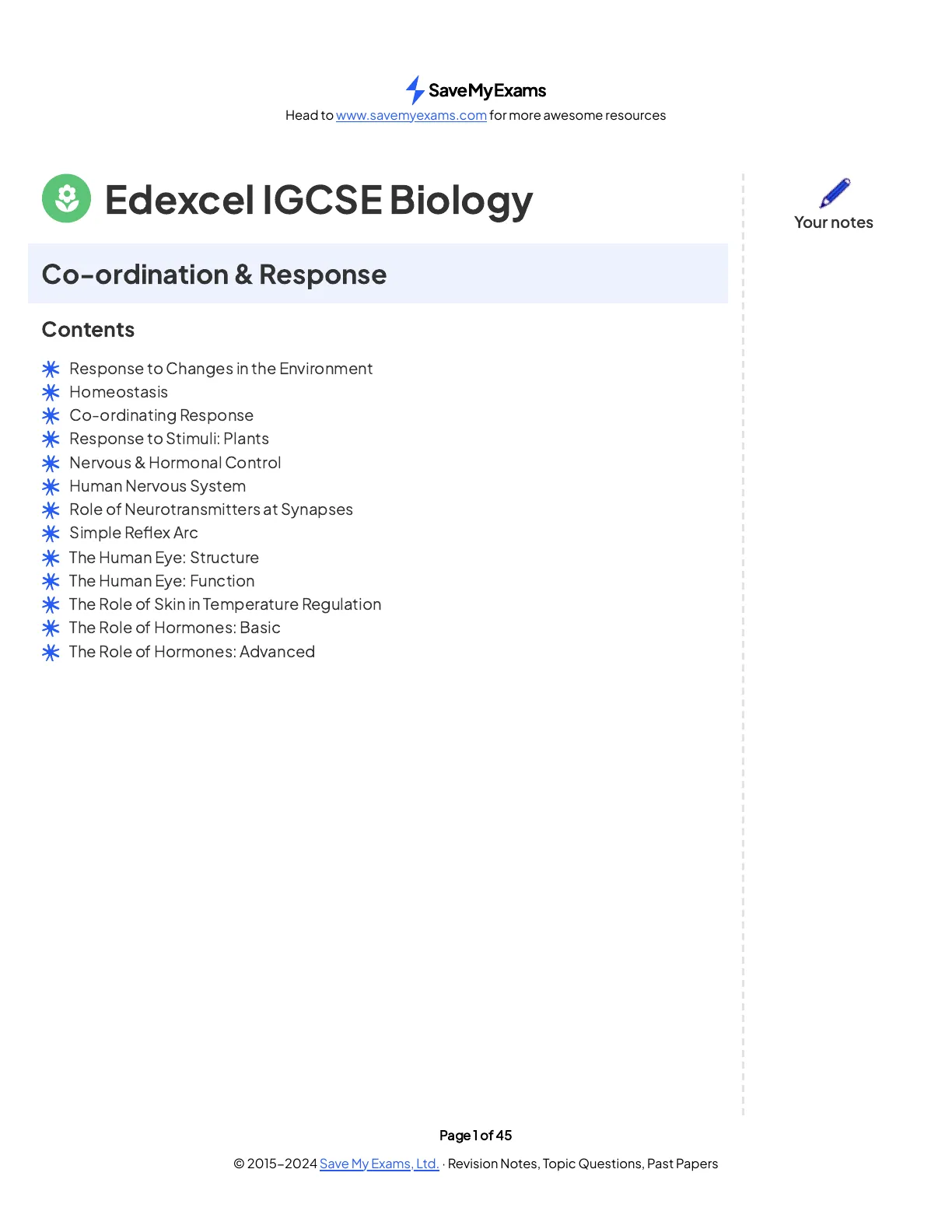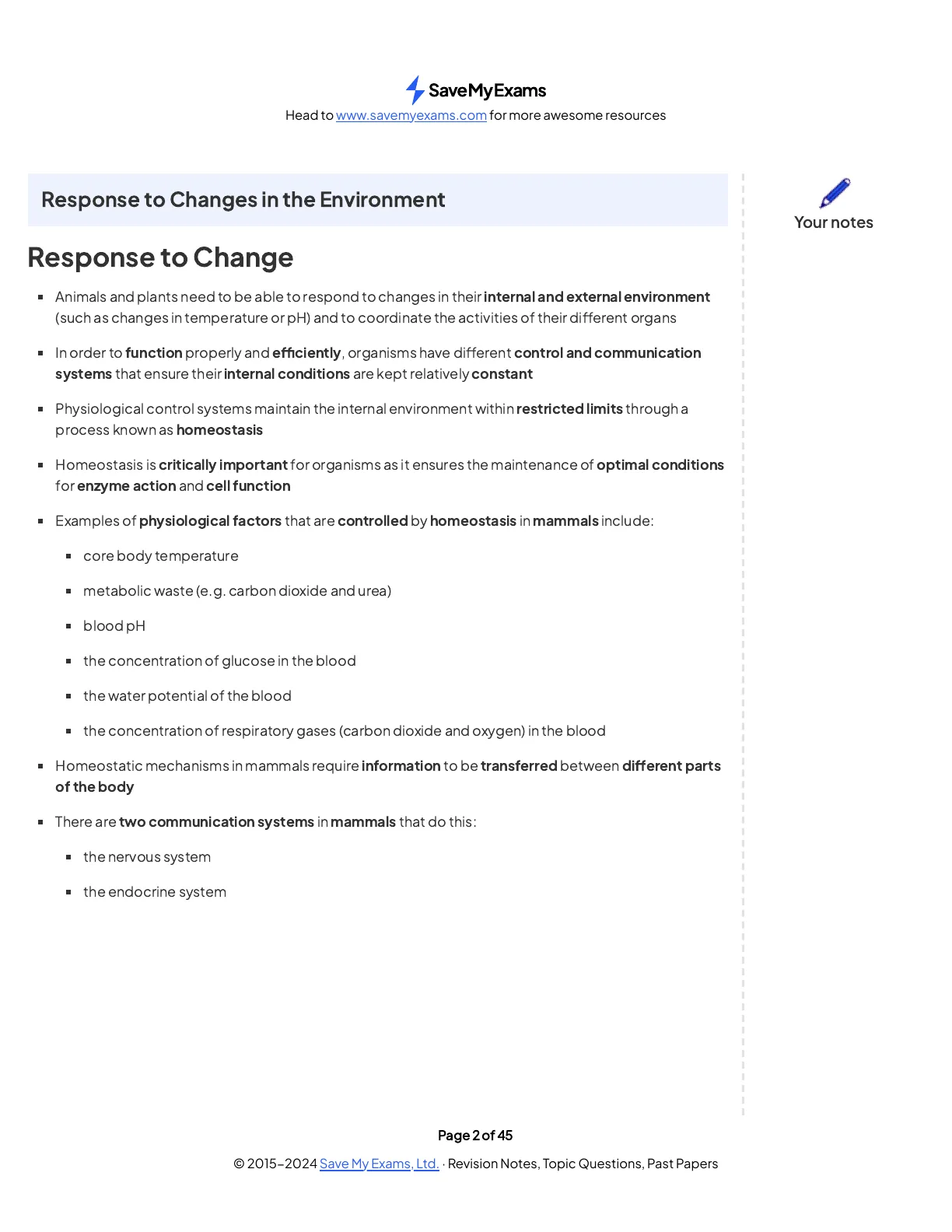Edexcel IGCSE Biology Notes: Coordination and Response in Organisms
Document from Savemyexams about Edexcel IGCSE Biology. The Pdf provides detailed notes on coordination and response in organisms, including the human eye and its function, suitable for high school Biology students.
See more45 Pages


Unlock the full PDF for free
Sign up to get full access to the document and start transforming it with AI.
Preview
Edexcel IGCSE Biology: Co-ordination & Response
Save My Exams Head to www.savemyexams.com for more awesome resources Edexcel IGCSE Biology Co-ordination & Response Contents
- Response to Changes in the Environment
- Homeostasis
- Co-ordinating Response
- Response to Stimuli: Plants
- Nervous & Hormonal Control
- Human Nervous System
- Role of Neurotransmitters at Synapses
- Simple Reflex Arc
- The Human Eye: Structure
- The Human Eye: Function
- The Role of Skin in Temperature Regulation
- The Role of Hormones: Basic The Role of Hormones: Advanced Your notes Page 1 of 45 2015-2024 Save My Exams, Ltd. . Revision Notes, Topic Questions, Past Papers
Response to Environmental Changes
Save My Exams Head to www.savemyexams.com for more awesome resources Response to Changes in the Environment Response to Change Animals and plants need to be able to respond to changes in their internal and external environment (such as changes in temperature or pH) and to coordinate the activities of their different organs In order to function properly and efficiently, organisms have different control and communication systems that ensure their internal conditions are kept relatively constant
- Physiological control systems maintain the internal environment within restricted limits through a process known as homeostasis
- Homeostasis is critically important for organisms as it ensures the maintenance of optimal conditions for enzyme action and cell function Examples of physiological factors that are controlled by homeostasis in mammals include:
- core body temperature
- metabolic waste (e.g. carbon dioxide and urea) blood pH
- the concentration of glucose in the blood
- the water potential of the blood the concentration of respiratory gases (carbon dioxide and oxygen) in the blood Homeostatic mechanisms in mammals require information to be transferred between different parts of the body There are two communication systems in mammals that do this: " the nervous system
- the endocrine system Your notes Page 2 of 45 2015-2024 Save My Exams, Ltd. . Revision Notes, Topic Questions, Past Papers
Homeostasis in Organisms
Save My Exams Head to www.savemyexams.com for more awesome resources Your notes Homeostasis Homeostasis is the control or regulation of the internal conditions of a cell or organism
- Some examples of these internal conditions include: water content (of an individual cell or of the body fluids of an organism)
- temperature
- pH
- blood pressure
- blood glucose concentration It is important for an organism to keep these internal conditions within set limits to ensure they stay healthy and to maintain optimum conditions to allow the organism to function in response to internal and external changes If these limits are exceeded, the organism may die Homeostasis maintains optimal conditions for enzyme action and all cell functions This ensures that reactions in body cells can function and therefore the organism as a whole can live Two examples of homeostasis in humans include the control of body temperature and the control of body water content
Control of Body Temperature in Humans
Control of body temperature in humans
- The core body temperature of humans is kept close to 37 ℃ This is very tightly controlled as a change in core body temperature of more than 2 ℃ can be fatal One reason for this is that such a temperature change would stop essential enzymes from functioning optimally For this reason, the human body must be able to make a coordinated response to any rise or fall in body temperature Body temperature is monitored and controlled by the thermoregulatory centre in the base of the brain as blood passes through it
- The thermoregulatory centre contains receptors that are sensitive to the temperature of the blood Page 3 of 45 2015-2024 Save My Exams, Ltd. . Revision Notes, Topic Questions, Past Papers
Save My Exams Head to www.savemyexams.com for more awesome resources The skin also contains temperature receptors and sends nervous impulses to the thermoregulatory centre
- The brain then coordinates a cooling or heating response, depending on what is required
Control of Body Water Content in Humans
Control of body water content in humans
- Water loss via the lungs (during breathing) or skin (during sweating) cannot be controlled, but the volume of water lost in the production of urine can be controlled by the kidneys The nephrons of the kidneys contain structures called tubules, through which filtrate passes on its way to the bladder
- Water can be reabsorbed from this filtrate as it passes along these tubules (known as collecting ducts) If the water content of the blood is too high then less water is reabsorbed, if it is too low then more water is reabsorbed This causes either a large amount of dilute urine to be produced, or a small amount of concentrated urine Ahormone called ADH controls this process Your notes Page 4 of 45 2015-2024 Save My Exams, Ltd. . Revision Notes, Topic Questions, Past Papers
Co-ordinating a Response
Save My Exams Head to www.savemyexams.com for more awesome resources Co-ordinating Response Co-ordinating a Response
- Homeostasis (maintaining controlled conditions within the body) is under involuntary (automatic) control This means that the brain stem (or non-conscious part of the brain) and the spinal cord are involved in maintaining homeostasis - you don't consciously maintain your body temperature or blood glucose level
- These automatic control systems may involve nervous responses or chemical responses (e.g. via hormones) All control systems that carry out co-ordinated responses require the following:
- A stimulus (a change in the environment e.g. a change in glucose levels in the blood, a change in body temperature etc.)
- Areceptor (receptor cells that detect stimuli) A coordination centre (such as the brain, spinal cord and pancreas), which receives and processes information from receptors
- An effector (a muscle or gland), which brings about responses to restore optimum levels Your notes Page 5 of 45 2015-2024 Save My Exams, Ltd. . Revision Notes, Topic Questions, Past Papers
Save My Exams Head to www.savemyexams.com for more awesome resources TOO LITTLE WATER IN BLOOD Your notes HYPOTHALAMUS DETECTS WATER LEVEL STIMULUS PITUITARY GLAND RELEASES ADH RECEPTOR BLOOD WATER LEVEL RETURNS · TO NORMAL MORE WATER · REABSORBED BY KIDNEYS EFFECTOR LESS WATER LOST IN URINE RESPONSE Copyright & Save My Al Rights Reserved A co-ordinated response (such as that required when there is not enough water in the blood) requires a stimulus, a receptor and an effector Page 6 of 45 2015-2024 Save My Exams, Ltd. . Revision Notes, Topic Questions, Past Papers
Plant Responses to Stimuli
Save My Exams Head to www.savemyexams.com for more awesome resources Response to Stimuli: Plants
- Plants need to be able to grow in response to certain stimuli For example, plants need to be able to grow in response to light, to ensure their leaves can absorb light for photosynthesis They also need to be able to grow in response to gravity, to ensure that shoots grow upwards and roots grow downwards
- The directional growth responses made by plants in response to light and gravity are known as tropisms If the growth is towards the stimulus, the tropism is positive and if the growth is away from the stimulus, the tropism is negative
Geotropic & Phototropic Responses of Plants
Geotropic & Phototropic Responses of Plants
- A response to light is a phototropism and a response to gravity is a geotropism (or gravitropism) As shoots grow upwards, away from gravity and towards light (so that leaves are able to absorb sunlight), shoots show a positive phototropic response and a negative geotropic response As roots grow downwards into the soil, away from light and towards gravity (in order to anchor the plant and absorb water and minerals from the soil), roots show a negative phototropic response and a positive geotropic response Geotropism and phototropism table
| Stimulus | Name of response | Definition | Positive response | Negative response |
|---|---|---|---|---|
| Light | Phototropism | Growth towards or away from the direction of the light source | Growth towards the light source (e.g. by shoots) | Growth away from the light source (e.g. roots) |
| Gravity | Geotropism | Growth towards or away from the source of gravity | Growth towards the source of gravity (e.g. by roots) | Growth away from the source of gravity (e.g. shoots) |
Your notes Page 7 of 45 2015-2024 Save My Exams, Ltd. . Revision Notes, Topic Questions, Past Papers
Save My Exams Head to www.savemyexams.com for more awesome resources Your notes LIGHT SOURCE Copyright Save My Exams. All Rights Reserved Plant shoots display a positive phototropic response by growing towards a light source
Role of Auxin in Phototropism
The Role of Auxin in Phototropism Plants produce plant growth regulators (similar to hormones in animals) called auxins to coordinate and control directional growth responses such as phototropisms and geotropism
- Auxin is mostly made in the tips of growing shoots and then diffuses down to the region where cell division occurs (just below the tip) This is an important point - only the region behind the tip of a shoot is able to contribute to growth by cell division and cell elongation Auxin stimulates the cells in this region to elongate (get larger); the more auxin there is, the faster they will elongate and grow If light shines all around the tip, auxin is distributed evenly throughout and the cells in the shoot grow at the same rate - this is what normally happens with plants growing outside
- When light shines on the shoot predominantly from one side, the auxin produced in the tip concentrates on the shaded side, making the cells on that side elongate and grow faster than the cells on the sunny side
- This unequal growth on either side of the shoot causes the shoot to bend and grow in the direction of the light Page 8 of 45 2015-2024 Save My Exams, Ltd. . Revision Notes, Topic Questions, Past Papers
Save My Exams Head to www.savemyexams.com for more awesome resources POSITIVE PHOTOTROPISM AUXINS ARE MADE 0 (SYNTHESISED) IN THE TIPS OF THE SHOOTS IN THE PRESENCE OF STRONG DIRECTIONAL LIGHT, AUXINS DIFFUSE AWAY FROM IT, TOWARDS THE SHADED SIDE UNEVEN GROWTH IS CAUSED BY THE UNEVEN DISTRIBUTION OF AUXIN to STRONG DIRECTIONAL LIGHT 6 go AUXINS WILL INCREASE GROWTH OF CELL IN MERISTEM SO WILL CAUSE SHADED SIDE SUNNY SIDE n 0 0 to SHADED SIDE TO GROW AND ELONGATE FASTER THAN THE SIDE IN THE LIGHT 10 Copyright & Save My Exams. All Rights Reserved save my exams Your notes Positive phototropism in plant shoots is a result of auxin accumulating on the shaded side of a shoot Examiner Tips and Tricks Make sure you are specific with your use of the term 'cell elongation' when answering exam questions on this topic. If you just say that the shoot 'grows towards the light' then that could imply that cell division takes place when it does not. Auxin causes the cells that already exist to get longer, it does not cause the overall number of cells to increase. Page 9 of 45 2015-2024 Save My Exams, Ltd. . Revision Notes, Topic Questions, Past Papers